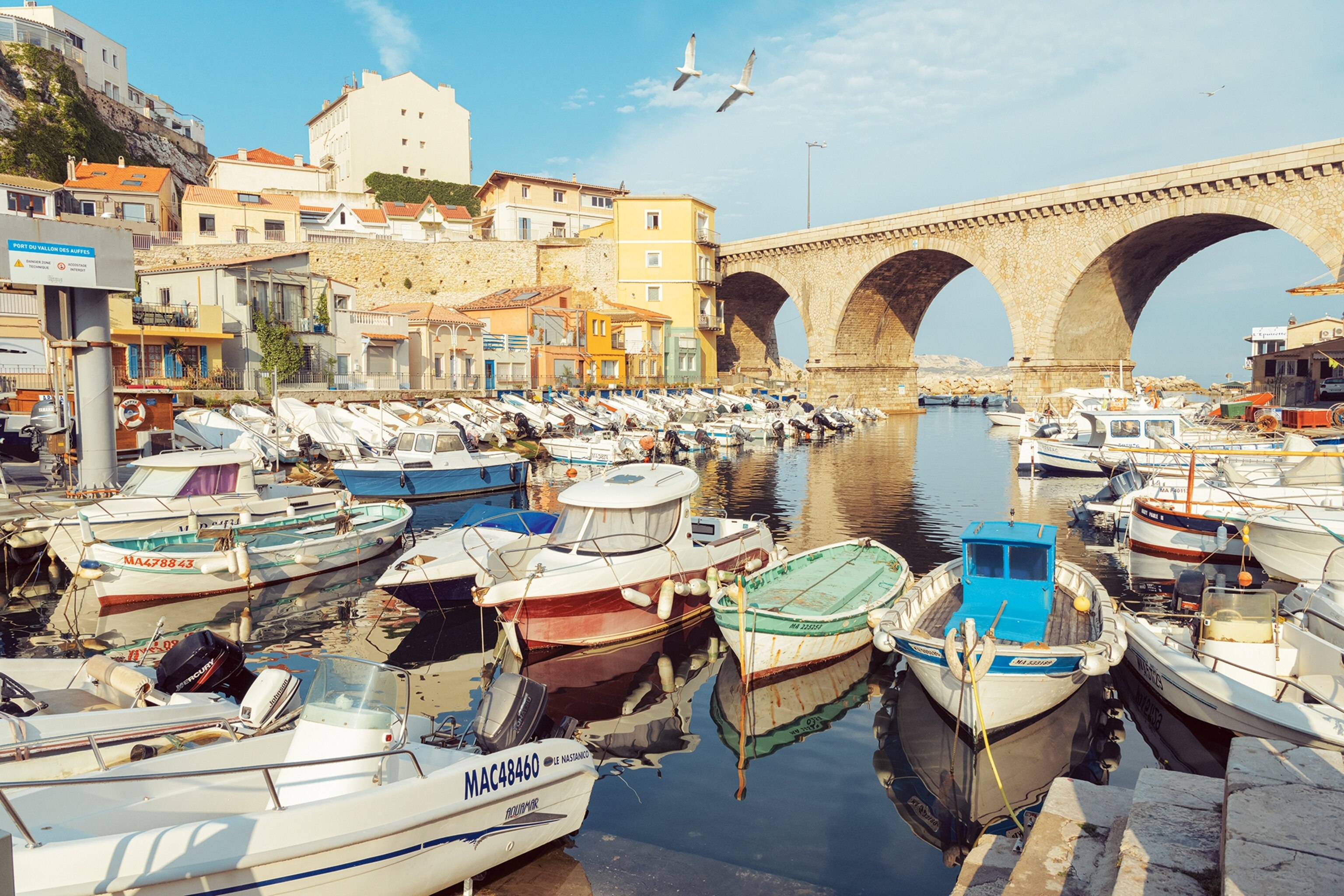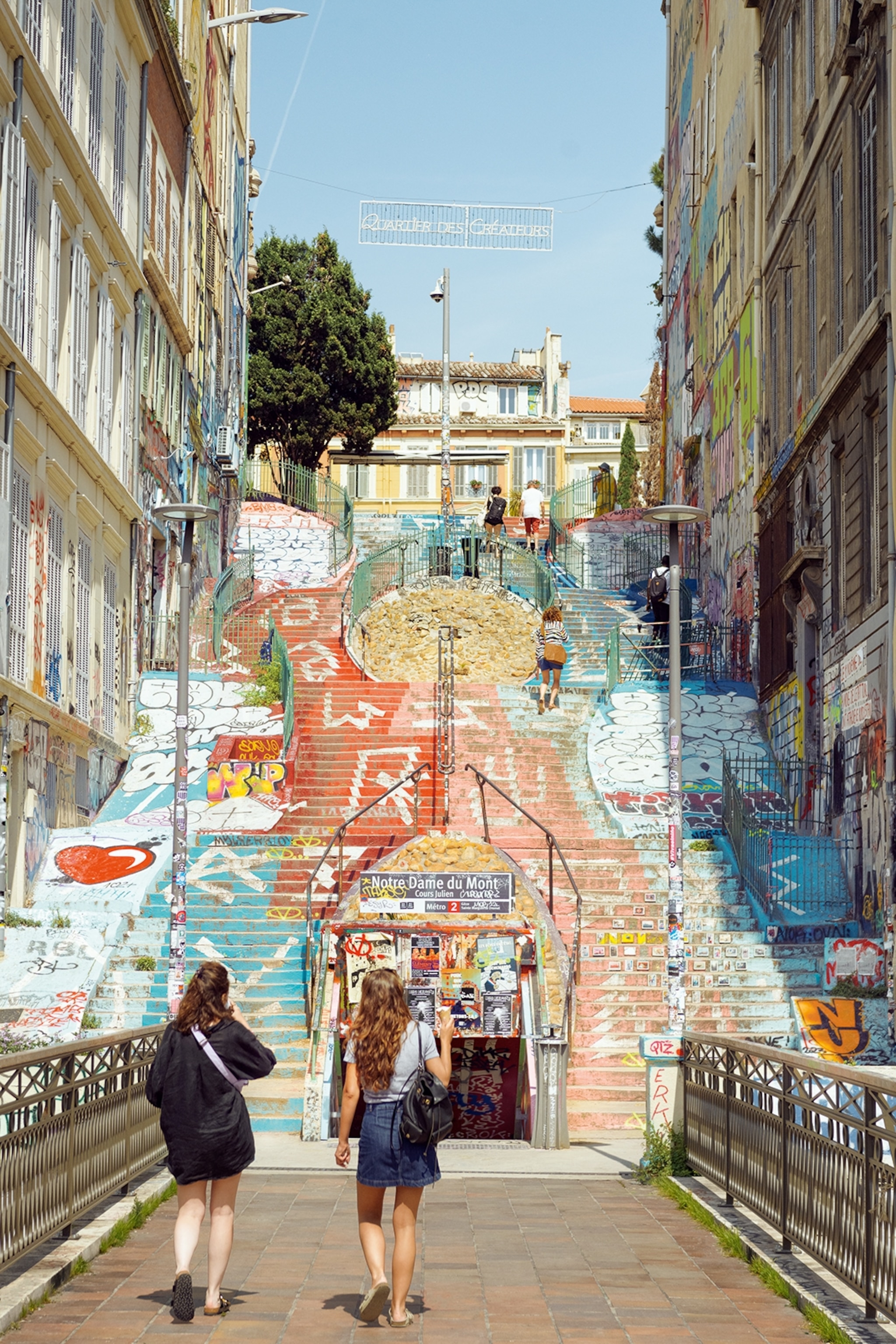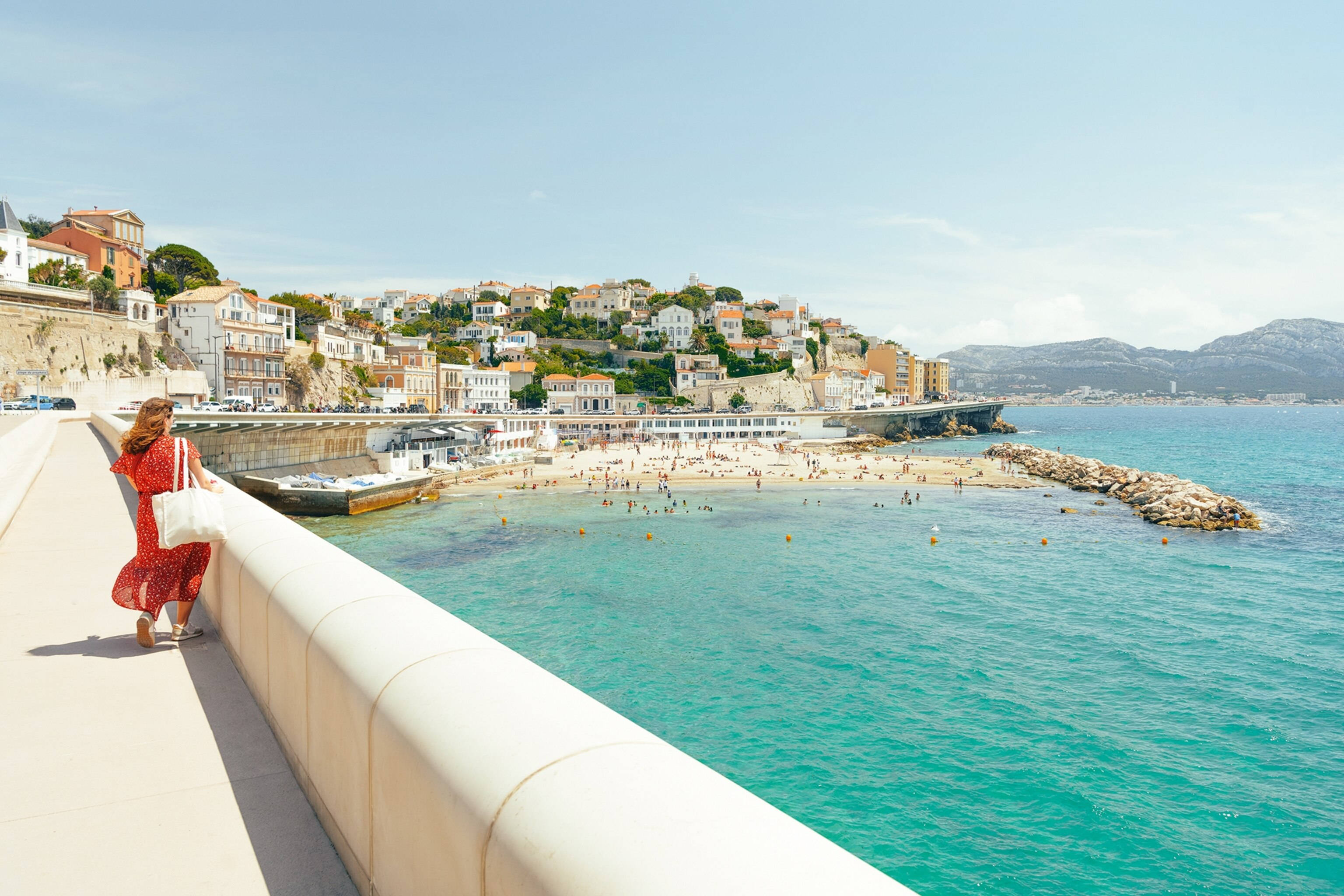
A guide to Marseille: beaches, bouillabaisse and street art on the French Med
As France gears up to host the Rugby World Cup, take the time to explore one of its key venues — a truly Mediterranean city in the midst of a decade-old renaissance.
“Marseille has a strong personality,” says tour guide Alexandra Blanc Véa as we take in the art of the graffiti-splashed Cours Julien district. A Paris native who’s been a resident of Marseille for over 20 years, she leads me down streets hastily sprayed with calls for strike action, to reach the grand, climate-conscious mural Man vs Wild. This piece by local artist Mahn Kloix covers the side of a house and shows a man in yellow trunks and flippers swimming to meet an enormous turtle.
“You either like it here or you don’t, but you can’t stay in the middle,” says Alexandra. Marseille has a fascinating past, and receives more sun than anywhere else in France. It has a glittering harbour, magnificent seafood and easy access to the rugged beauty of nearby Calanques National Park. But bits of it are undeniably falling apart, after a mid-20th century slump in its fortunes that has only recently begun to improve. Marseille wouldn’t be the first great trading port to combine grit and grandeur, but its unpolished image sets it apart from most French cities.
At least there is plenty of material for street art tours. Cours Julien’s colourful streets spider off from a central square lined with bistros and bars, all abuzz with chatter. Almost every square inch of concrete is a canvas for bug-eyed cartoons, surreal patterns or eviscerating political statements.
This hilltop neighbourhood is the heart of a youthful and modern Marseille, but down at the cinematic Vieux Port (‘Old Port’) there’s also a buzz from the departing tour boats, harbourside cafes and fishermen selling their morning’s catch at makeshift stalls. Bouillabaisse, a traditional seafood stew, originates in this city and is said to have been invented by its fishermen, who boiled some of their catch in seawater while out at sea.

Maritime history runs deep in Marseille, where a pair of imposing forts flank the harbour entrance and a scattering of small, rocky islands lie in the sparkling sea just beyond. It was founded by Greek-speaking Phocaeans 2,600 years ago, making it France’s oldest city. As French colonial rule expanded across the globe in the 19th century, Marseille’s strategic location on the Mediterranean transformed the city into a place where all kinds of people, goods and ideas converged. But its hard-edged reputation in the late 20th century meant it never received the same attention as Cannes and Nice, further east along the Riviera.
Things changed in 2013 when Marseille served as European Capital of Culture and its waterfront was embellished with eye-catching projects. Foremost of these is the bold glass and black concrete lattice structure of Mucem, the Mediterranean culture museum, designed by Algerian-born architect Rudy Ricciotti. Next to it is the angular, cantilevered Villa Méditerranée, which houses a replica of the south-coast Cosquer Cave and its prehistoric rock art engravings. And at the inner end of the Vieux Port is L’Ombrière de Norman Foster, with its clever, mirrored canopy, dreamt up by the eponymous UK architect.
“Because of this, a lot of tourists suddenly came to visit and they realised the city was very interesting,” Alexandra says. “And that you have to go further, beyond the reputation.” Ten years after it drew the eyes of the rest of the world, and as it prepares to host several games at the 2023 Rugby World Cup, Marseille is once again in the spotlight.
What to see & do
Part of Marseille’s post-2013 revival, this is the first museum dedicated entirely to the culture of the Mediterranean. Exhibitions cover everything from trade and conflict to questions on why the Mediterranean diet is thought to lead to longer lives. The museum’s concrete lattice shell rises from the Vieux Port’s north shore, and is linked by a footbridge 60ft above the lapping waves to the 17th-century bastion of Fort Saint-Jean, offering stunning harbour views.
Alexandra Blanc Véa’s tours of the Cours Julien neighbourhood and its street art give context and colour to Marseille’s distinct identity. Learn about how hip hop influenced the city’s graffiti culture, why new art is being painted directly onto street surfaces and what avoir la banane (‘to have the banana’) means. There’s also a chance to meet local street artists, such as Mahn Kloix, in their studios. Book tours in English via groupes@marseille-tourisme.com
North of the Vieux Port, Marseille’s oldest district was settled by the ancient Greeks. These days, it’s a typically Mediterranean street scene, with hanging baskets and pastel-green shutters. Street art and sun-dappled corner cafes add further colour. Downhill from the neighbourhood is the grandiose, 19th-century Marseille Cathedral, with its Byzantine-style domes.


City beaches
Marseille’s coast may lack the glamour of Saint-Tropez and Antibes, but its 21 beaches still provide a change of pace. Those of the Prado are the largest, while Plage des Catalans is the closest to the centre, just a 15-minute walk from the Vieux Port. Its 100 yards of sand are popular with locals, from volleyball players to tracksuit-clad retirees striking yoga poses.
Two miles from the Vieux Port, and reached by frequent sightseeing boats, is the rocky fortress made famous by its fictional inmate Edmond Dantès, otherwise known as the Count of Monte Cristo. Completed in 1531, the main castle is flanked by three stone towers, and its imposing walls, prison cells and ramparts can be explored on a self-guided tour.
Six miles south of the city is a coastline of limestone cliffs, carved into deep inlets over millions of years. This landscape of secluded coves and white rock dotted with sparse, brilliantly green vegetation is a favourite day trip from Marseille. Despite the lack of soil, it’s home to around 9,000 plant species, as well as rare birds such as the Bonelli’s eagle. Boat tours of the coast are popular, as are kayaking and paddleboarding. Road access into the park is restricted, but hikes from inland trailheads can open up this remarkable landscape.
Where to go shopping
With a wrought iron canopy above the door, and alluring oak, coffee and chocolate aromas permeating the air, this combined cafe and chocolaterie has been running for nearly a century, and its heritage seduces immediately on stepping inside. Head home with handfuls of shining pralines, spongy nougat and rainbow-coloured bonbons. There are branches around town — the flagship is on the central avenue of La Canebière.
Savonnerie Marseillaise de la Licorne
Marseille has been producing soap for over 600 years, mixing sea water, olive oil and alkaline ash from sea plants. Traditionally pistachio-green, it now comes in a variety of colours. Look out for a painted wooden boat in a shop window on the Vieux Port’s south shore, before entering a space filled with rustic maritime decor and a heady blend of sweet scents.
This concept craft store in Le Panier celebrates the warm tones of the Mediterranean through clothing, jewellery, decorations and photography. Locally designed T-shirts hang next to polaroid images of Marseille strung out on miniature clothes pegs, while potted plants add a homely charm to the room.

Where to eat in Marseille
Part cafe, part bookshop, this quirky spot in Cours Julien masters French morning staples such as powerful black coffee and fluffy croissants. The real draw, though, are the dusty shelves of classic novels, an incongruous 1950s rock ’n’ roll soundtrack and a hodge-podge of rustic decor, including patterned rugs and kitsch chandeliers.
Straw-hatted Mustapha Kachetel is the fourth-generation owner of this Marseille institution. The North African cuisine pays homage to his Berber family, who hail from northern Algeria’s mountainous Kabylia region. Barley couscous forms an inviting bed for lamb, beef and chicken stews, all of which can be enlivened with hits of fiery harissa.
Chef Christian Buffa’s fine interpretation of the quintessential Marseillais dish bouillabaisse is a masterclass in dramatic presentation and fidelity to the original recipe. Impeccably suited waiters in gleaming shoes glide between tables before presenting the classic fisherman’s soup, a richly flavoured Provençal broth of John Dory, anglerfish, eel and potatoes, with a dash of pastis added for good measure. The deboned fish are served separately.


Like a local
Secluded harbour
A 30-minute walk south of the Vieux Port, in part along the steeply set coast road, lies the more secluded Vallon des Auffes, a tiny enclosed fishing harbour flanked by some lovely wine bars and bistros. The craggy surrounding cliffs and stone bridge arching across the harbour entrance make for a postcard scene, but this languid afternoon sun trap is best enjoyed with a cold drink in hand.
While bouillabaisse is the dish most associated with Marseille, the city also has a deep affection for pizza. The wood-fired offerings are sublime at beloved, 25-seat La Bonne Mère, which sits on a small square in the hilly Vauban neighbourhood. Don’t miss the punchy anchovy pizza on a simple tomato base dotted with olives.
Market scenes
Assorted markets set up every morning on the streets of this historic trading port. The Marché des Capucins in the old-world Noailles district brings an array of powerful North African spice aromas, while the Marché de la Plaine hawks everything from potent red chilli peppers to colourful puffer jackets.

Where to stay in Marseille
Swiss-French architect Le Corbusier’s iconic Cité Radieuse is a UNESCO-listed modernist apartment building that also houses 21 hotel rooms. The wooden panelling and splashes of colour in its minimalist rooms are effortlessly cool. It’s two miles from the city centre, close to the stadium that will host the rugby. The private rooftop offers wonderful views.
Scandi-modernist rooms spread across two converted 18th- and 19th-century townhouses in a relatively quiet neighbourhood just a few minutes on foot south of the Vieux Port. The bamboo garden is a welcome secluded green space in this part of the city, and one of Marseille’s finest breakfast settings.
From this hotel’s hilltop perch, guest rooms offer some of the best views of the harbour’s shimmering waters, bobbing masts and distant jumble of rooftops. Expect exceptional service and generously sized rooms, and don’t miss the sun-drenched rooftop cocktail bar.
After hours in the city
Pounding beats reverberate through the walls of this live rock venue, in business for over 30 years and located on a sloping side street off Cours Julien. Despite its rock focus, theme nights take in everything from hip hop to soul. It’s a low-key, fairly intimate space, drawing an eclectic crowd.
This laid-back bar in the foothills behind the ramparts of Fort Saint-Nicolas, south of the harbour mouth, is the only one in Marseille to make all its wine on site; the metal vats where the grape juice is vinified can be seen behind the counter. A regularly updated chalkboard announces food pairings, which could range from tuna sashimi to devilled eggs.
Hemmed in between a cigar shop and a Tunisian restaurant near the Vieux Port, this lively spot is deceptively spacious inside and its taps pour over 25 different beers, explained in detail on a big screen above the bar. Nineties grunge often thumps through the stereo, while a vast range of sours, stouts and IPAs keeps the patrons happy.
To subscribe to National Geographic Traveller (UK) magazine click here. (Available in select countries only).
You May Also Like
Go Further
Animals
- Orangutan seen using plants to heal wound for first timeOrangutan seen using plants to heal wound for first time
- What La Palma's 'lava tubes' tell us about life on other planetsWhat La Palma's 'lava tubes' tell us about life on other planets
- This fungus turns cicadas into zombies who procreate—then dieThis fungus turns cicadas into zombies who procreate—then die
- How can we protect grizzlies from their biggest threat—trains?How can we protect grizzlies from their biggest threat—trains?
Environment
- What La Palma's 'lava tubes' tell us about life on other planetsWhat La Palma's 'lava tubes' tell us about life on other planets
- How fungi form ‘fairy rings’ and inspire superstitionsHow fungi form ‘fairy rings’ and inspire superstitions
- Your favorite foods may not taste the same in the future. Here's why.Your favorite foods may not taste the same in the future. Here's why.
- Are the Great Lakes the key to solving America’s emissions conundrum?Are the Great Lakes the key to solving America’s emissions conundrum?
- The world’s historic sites face climate change. Can Petra lead the way?The world’s historic sites face climate change. Can Petra lead the way?
History & Culture
- Meet the ruthless king who unified the Kingdom of Hawai'iMeet the ruthless king who unified the Kingdom of Hawai'i
- Hawaii's Lei Day is about so much more than flowersHawaii's Lei Day is about so much more than flowers
- When treasure hunters find artifacts, who gets to keep them?When treasure hunters find artifacts, who gets to keep them?
Science
- Why ovaries are so crucial to women’s health and longevityWhy ovaries are so crucial to women’s health and longevity
- Orangutan seen using plants to heal wound for first timeOrangutan seen using plants to heal wound for first time
Travel
- 5 of Uganda’s most magnificent national parks
- Paid Content
5 of Uganda’s most magnificent national parks - On this Croatian peninsula, traditions are securing locals' futuresOn this Croatian peninsula, traditions are securing locals' futures
- Are Italy's 'problem bears' a danger to travellers?Are Italy's 'problem bears' a danger to travellers?






